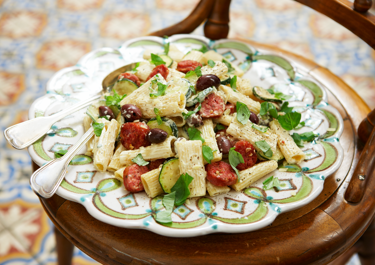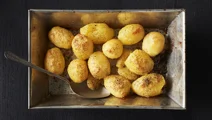Rigatoni

Rustic rigatoni, a delicious Italian pasta dish with all the right flavours. Feel free to invest in Italian sausage for the genuine taste.
Ingredients
|
300 g
Pasta rigatoni
|
|
|---|---|
|
300 g
Sausages
|
|
|
2
Chopped garlic cloves
|
|
|
1 tbsp
Butter & rapeseed oil
|
|
|
200 ml
Sour cream, 13%
|
|
|
100 ml
Dry white wine
|
|
|
76 g
Black olives
|
|
|
Salt and pepper to taste
|
|
|
105 g
Cheddar cheese, grated
|
|
|
8 g
Chopped fresh basil
|
Instructions
Rigatoni
How do you keep rigatoni from flattening?
The best way to preserve the shape of your pasta tubes is to make sure that they are not overcooked and soggy. You are probably familiar with the term al dente. Cooking your pasta ‘to the tooth’ means that the shapes still have a bit of texture to bite into. They should by no means be crispy or hard, but the centre of the pasta should offer some chewing resistance. Follow the timing recommendations for your rigatoni and make sure to taste and test the texture during the last two minutes or so.
How long should you boil rigatoni?
Rigatoni is a fairly chunky pasta shape, which leads to longer cooking times. Dried pasta is almost always sold in packaging that gives a recommended cooking time – usually around 11-13 minutes. However, the only way to know when your pasta is ready for straining is by tasting and testing the texture of one or more pieces. When the pasta feels cooked, but still has a bit of resistance at the centre, it’s al dente and good to go. Don’t rinse your pasta after straining, as this removes starch that adds to the flavour and texture of your finished pasta dish.
What is the difference between rigatoni and penne?
Rigatoni and penne are both tubular and ridged pasta shapes, great for combining with rich pasta sauces. Rigatoni – ‘stripy and large’ in Italian – are larger than penne and cut at a right angle. Penne rigate – ‘stripy pens’ – are the thinner of the two and are cut at a diagonal angle.
Rigatoni pasta: the ultimate comfort food
You can never have too many quick and easy pasta recipes up your sleeve. This one comes together in under 30 minutes and delivers rich, comforting flavours and textures.
A pasta type made for filling and sauces
Rigatoni is a ridged, tube-shaped pasta type. Its generous size and ridged surface make sure that you enjoy plenty of your favourite pasta sauce with every bite. If you can find it, go for rigatoni that is pale in colour and with a rough surface from bronze die extrusion. The rough surface helps your sauce cling even better to the rigatoni.
The history behind the pasta tube
While the history of pasta in different shapes stretches back for many centuries, rigatoni and other tubular pasta are relatively new additions. It was only with the invention of industrial pasta machines, starting in the 17th century, that tube shapes became a thing. It was also the industrial process that enabled the ridged, ‘rigato’, surfaces of rigatoni, penne, and other shapes. The exact birth date of rigatoni is unknown. However, the process of diagonally cutting penne rigate was patented on 11 March, 1865.
Oven-baking rigatoni
Rigatoni are excellent for making pasta al forno – oven baked pasta. This is hearty comfort food, perfect for when you’re feeding a crowd. All you need is cooked rigatoni, your favourite rich, tomato-based sauce with or without meat, and lots of good cheese to melt on top. First, pour the rigatoni and sauce into a greased oven pan. Then use a spatula or spoon to toss and mix the sauce with the pasta. Finally, sprinkle a good layer of grated cheese on top and bake at 200°C until the cheese has a nice, browned colour.








